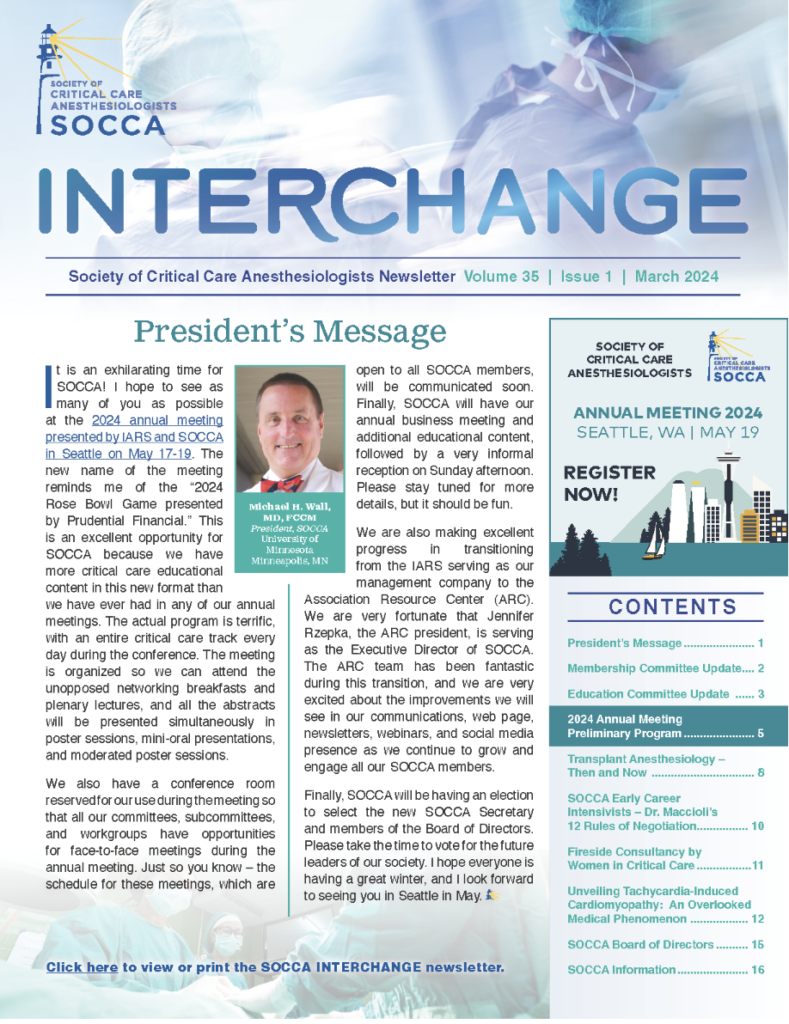Notable Trials: 2019 in Review
Editor’s Note
Jarva Chow recently reviewed notable trials from 2019 at the Anesthesia Year in Review session during SCCM’s 49th Annual Congress in Orlando, Florida. Six particularly relevant trials are summarized below.
Effect of Postextubation High-Flow Nasal Oxygen With Noninvasive Ventilation vs High-Flow Nasal Oxygen Alone on Reintubation Among Patients at High Risk of Extubation Failure: A Randomized Clinical Trial
Background: Both non-invasive positive pressure ventilation and high-flow nasal oxygen have been previously but separately demonstrated to reduce the risk of re-intubation.
Question: In mechanically ventilated adults at high risk for re-intubation, does the addition of non-invasive positive pressure ventilation to high-flow nasal oxygen reduce the risk of re-intubation compared to high-flow nasal oxygen alone?
Design: Multicenter, randomized controlled trial.
Interventions: In the intervention arm, when feasible, non-invasive positive pressure ventilation was continued for as long as possible with fall back to high-flow nasal oxygen at 50 liters per minute versus high-flow nasal oxygen only in the control group.
Setting and Population: Adults mechanically ventilated for more than 24 hours who underwent a successful SBT but met criteria suggestive of risk for extubation failure in 30 ICUs across France.
Outcomes and Results: Reintubation within 7 days 11.8% in the non-invasive positive pressure plus high-flow nasal oxygen group, 18.2% in the high-flow nasal oxygen only group (difference -6.4% [95% CI, -12.0 to -0.9], P=0.02).
Conclusions: The addition of non-invasive positive pressure ventilation reduces the risk of extubation failure in high-risk adults.
Points for Consideration: Non-invasive positive pressure ventilation was a frequent rescue modality in the control arm. SBT consisted of t-piece trials, which may not be consistent with typical practice in certain clinical environments.
Reference: Thille AW, Muller G, Gacouin A, Coudroy R, Decavele M, Sonneville R, et al. Effect of Postextubation High-Flow Nasal Oxygen With Noninvasive Ventilation vs High-Flow Nasal Oxygen Alone on Reintubation Among Patients at High Risk of Extubation Failure: A Randomized Clinical Trial. JAMA. 2019;322(15):1465-75.
Early Sedation with Dexmedetomidine in Critically Ill Patients
Background: While the ideal ICU sedative agent is unknown, some evidence exists to support dexmedetomidine as an efficacious and well-tolerated agent associated with less delirium.
Question: In mechanically ventilated adults, does primary sedation with dexmedetomidine versus other agents impact all cause 90-day mortality?
Design: Multicenter, randomized controlled trial.
Interventions: Dexmedetomidine as a sole sedative agent up to 1.5 mcg/kg/hr w/w/o adjunctive agents if sedative goals not met versus other sedation strategies (e.g., midazolam or propofol) dictated by the clinical team.
Setting and Population: Critically ill adults on mechanical ventilation for at least 12 hours and expected to remain ventilated for 48 hours in 74 ICUs across 8 countries.
Outcomes and Results: 90-day mortality 29.1% in the dexmedetomidine group, 29.1% in the usual care group (OR 1.0 [95% CI, 0.87 to 1.15], P=0.98).
Conclusions: Use of dexmedetomidine as a sole (or primary) sedative agent did not reduce 90-day mortality.
Points for Consideration: In the dexmedetomidine group, 74.5% of patients required adjunctive sedation. Dexmedetomidine was associated with serious adverse events, including bradycardia, sinus arrest, and hypotension.
Reference: Shehabi Y, Howe BD, Bellomo R, Arabi YM, Bailey M, Bass FE, et al. Early Sedation with Dexmedetomidine in Critically Ill Patients. N Engl J Med. 2019;380(26):2506-17.
Early Neuromuscular Blockade in the Acute Respiratory Distress Syndrome
Background: Following publication of ACURASYS in 2010, neuromuscular blockade with cisatracurium has been incorporated in the care of patients with acute respiratory distress syndrome (ARDS).
Question: In patients with moderate to severe ARDS, does early neuromuscular blockade versus light sedation result in lower all cause 90-day mortality?
Design: Multicenter, randomized controlled trial.
Interventions: Cisatracurium 15 mg bolus with 37.5 mg/h infusion versus light sedation with RASS goal 0 to -1 (or equivalent).
Setting and Population: Critically ill adults with ARDS and P:F ratio < 150 in 48 ICUs across the United States
Outcomes and Results: 90-day mortality 42.5% in the cisatracurium group, 42.8% in the light sedation group (difference -0.3% [95% CI -6.4 to 5.9], P=0.93).
Conclusions: Patients with moderate to severe ARDS failed to demonstrate an improvement in mortality when treated with early neuromuscular blockade versus light sedation.
Points for Consideration: The findings of this study conflict with ACURASYS, which has led to some questioning by clinicians as to the best path forward. In the ROSE trial many patients screened met exclusion criteria as they had already received neuromuscular blockade, and prone positioning was uncommon. The question remains as to whether neuromuscular blockade may have a role in patients with profound ventilator dyssynchrony.
Reference: Moss M, Huang DT, Brower RG, Ferguson ND, Ginde AA, Gong MN, et al. Early Neuromuscular Blockade in the Acute Respiratory Distress Syndrome. N Engl J Med. 2019;380(21):1997-2008.
Conservative Oxygen Therapy during Mechanical Ventilation in the ICU
Background: Although ubiquitous, questions have arisen about whether excess supplemental oxygen exposure may lead to deleterious clinical outcomes in at-risk patient groups.
Question: In mechanically ventilated adults, does conservative oxygen therapy versus conventional oxygen therapy impact the number of ventilator-free days?
Design: Multicenter, randomized controlled trial.
Interventions: The intervention arm targeted the lowest possible FiO2 to achieve a SpO2 of 91-96% versus the control arm with usual oxygen therapy targeting any SaO2 > 90%.
Setting and Population: Mechanically ventilated adults expected to remain intubated for at least 48 hours in 21 ICUs across Australia and New Zealand.
Outcomes and Results: Ventilator free days 21.3 days in the conservative oxygen therapy group, 22.1 in the control group (difference -0.3% [95% CI -2.1 to 1.6]).
Conclusions: Conservative oxygen therapy versus conventional therapy does not reduce the number of ventilator-free days in critically ill adults.
Points for Consideration: A reasonable degree of clinical separation was achieved between the two groups; however, typical FiO2 in the control arm was still relatively low. A larger (i.e., N=40,000) trial has been proposed by the investigators.
Reference: Mackle D, Bellomo R, Bailey M, Beasley R, Deane A, Eastwood G, et al. Conservative Oxygen Therapy during Mechanical Ventilation in the ICU. N Engl J Med. 2019.
Effect of a Resuscitation Strategy Targeting Peripheral Perfusion Status vs Serum Lactate Levels on 28-Day Mortality Among Patients With Septic Shock: The ANDROMEDA-SHOCK Randomized Clinical Trial
Background: Current guidelines recommend examination of lactate kinetics to judge the adequacy of fluid resuscitation. However, lactate kinetics are increasingly appreciated to be complex, and clinical markers of resuscitation may be equally valid.
Question: In adults with early septic shock, does resuscitation guided by peripheral perfusion (i.e., capillary refill) versus lactate improve all-cause 28-day mortality?
Design: Multicenter, randomized controlled superiority trial.
Interventions: Measurement of capillary refill every 30 minutes until normalization (i.e. ≤ 3 seconds) versus lactate measurement every 2 hours for a total of 8 hours with a goal of 20% clearance every 2 hours.
Setting and Population: Adults with early septic shock admitted to an ICU in 28 hospitals across South and Central America.
Outcomes and Results: 28-day mortality 34.9% in the peripheral perfusion group, 43.4% in the lactate group (HR 0.75 [95% CI, 0.55 to 1.02], P=0.06).
Conclusions: No statistically significant difference in 28-day mortality demonstrated between the two trial arms.
Points for Consideration: Capillary refill may be an alternative to serial lactate measurements to guide resuscitation in septic shock. This may be particularly appealing in resource-limited environments.
Reference: Hernandez G, Ospina-Tascon GA, Damiani LP, Estenssoro E, Dubin A, Hurtado J, et al. Effect of a Resuscitation Strategy Targeting Peripheral Perfusion Status vs Serum Lactate Levels on 28-Day Mortality Among Patients With Septic Shock: The ANDROMEDA-SHOCK Randomized Clinical Trial. JAMA. 2019;321(7):654-64.
Bag-Mask Ventilation During Tracheal Intubation of Critically Ill Adults
Background: Airway management in critical care settings is fraught with risk, including the potential for aspiration. Although avoidance of bag-mask ventilation after administration of sedative hypnotics w/w/o neuromuscular blocking drugs is often avoided in routine procedural settings if concern exists for aspiration, critically ill patients often cannot tolerate even brief periods of apnea.
Question: In critically ill adults requiring intubation does bag-mask ventilation between induction and intubation reduce the risk of hypoxemia?
Design: Multicenter, randomized controlled trial.
Interventions: Bag-mask ventilation with FiO2 1.0 and 10 breaths per minute with adjuncts (e.g., oral airway, two hands, PEEP) versus pre-oxygenation by bag-mask only without positive pressure ventilation.
Setting and Population: A diverse population of critically ill adults in 7 ICUs across the United States
Outcomes and Results: Lowest mean oxygen saturation 96% in the bag-mask ventilation group, 93% in the control group (mean difference 3.9 [95% CI, 1.4 to 6.5], P=0.01).
Conclusions: Patients receiving positive pressure ventilation via bag-mask demonstrated higher oxygen saturations and lower rates of severe hypoxemia (as a secondary outcome measure).
Points for Consideration: While patients demonstrated less hypoxemia, this primary outcome cannot speak to mortality or other clinically important endpoints. The trial was not adequately powered to assess for aspiration risk, and such observations would likely be subject to confounding (i.e., technique).
Reference: Casey JD, Janz DR, Russell DW, Vonderhaar DJ, Joffe AM, Dischert KM, et al. Bag-Mask Ventilation during Tracheal Intubation of Critically Ill Adults. N Engl J Med. 2019;380(9):811-21.




































